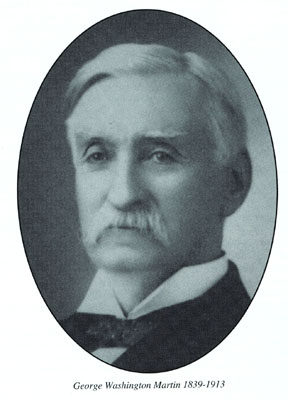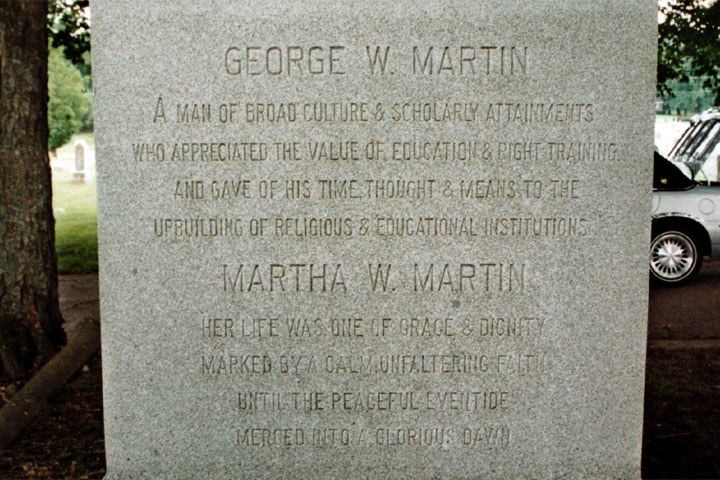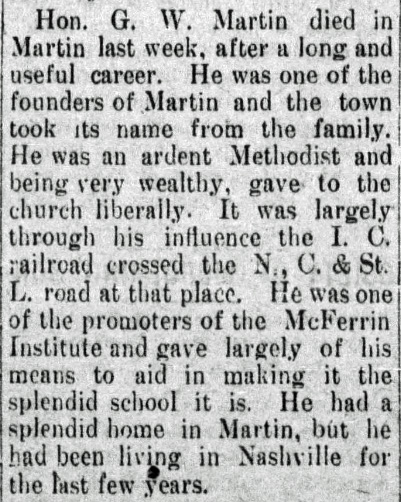"Three of the sons of William Martin were instrumental in the development of the city of Martin, Tennessee. George Washington Martin, Marshall Presley Martin, and William Hartwell Martin. They were operating a sawmill in Gardner, Tennessee in 1872 when they learned that the north-south route of the Mississippi Central Railroad was to be built through the Gardner area. They quickly and quietly offered the railroad officials free right-of-way through their land, three miles to the east, and an additional strip of land for a park which would be in the center of the town. The railroad officials could hardly refuse, seeing an economic advantage in having their line cross the north-south railroad which was on the Martin property.
By early 1873 a town was planned, a map was made, streets were cleared, and the Martin brothers began selling land. P. W. Lee, his brother, Frank, and Alexander Clemons helped the Martin brothers plan the small village.
George W. owned the land on the east side of the north-south proposed tracks, while Marshall P. and William H. owned land on the west side. Each brother, wanting the town to develop on his land, compromised and had the town planned on both sides of the railroad. Their brother, Thomas Dudley Martin owned a large section of land on the east side of the city (present location of the Industrial Park) and their sister, Virginia, owned land further east. Some of the early deeds show their names, but this was property that they inherited from their brother, William Hartwell, who died in 1878 in the yellow fever epidemic.
George W., eight years older than Marshall P. and eleven years older than William H., took the lead in dealing with the railroad and laying out the town. He was educated at the Male Academy in Dresden, Bethel College in McLemoresville, and Union University in Rutherford County. He was the first president and stockholder in the Bank of Martin, and helped organize the Bank of Fulton in Kentucky. He served in the 38th and 42nd General Assemblies in the House of Representatives, and the 40th and 44th General Assemblies in the Senate. He was involved in many business ventures regarding the development of the city. In 1878 he was married to Mattie Lee Williams. The couple had no children. . . . . . . "
". . . . . . As soon as the Mississippi Central agreed to pass through the Martin's land, the brothers got busy. In May 1872, George W. and Marshall P. sold one half interest of their mill in Gardner to W.H.M. Brooks and wife. They moved some of the milling equipment and established a sawmill about 200 yards southwest of the proposed railroad crossing. . . . . . ."
". . . . . . From the sawmill, lumber went into the building of a passenger station to be used by both railroads, near the crossing. A large frame hotel was quickly constructed near the passenger station by George Martin and named The Martin House. William Hartwell Martin supervised construction and H.P. Miller was put in charge. The town of Martin began to blossom. In five years there were 710 people living within the city limits. . . . . . . . ."
". . . . on the southwest corner of Main and McCombs, George W. Martin gave a lot to the Methodist Church South on August 15, 1877. It was 50 by 125 feet. A frame church building had already been erected on the site in 1876. In 1895 this building was purchased by the Cumberland Presbyterians and moved east on Main to a lot purchased from J.F. Looney."
-------------------------------------------------
Goodspeed's History of Tennessee - "Hon. G. W. Martin was born within one mile of the present village of Martin, Tenn., on the 16th of October, 1839, and was one of a family of nine children. His parents, William and Sarah Martin, were born in the State of Virginia, the former in 1806. They were married in their native State, and soon after moved to Weakley County, Tenn., where they ever afterward made their home. The father at the time of his death, in 1858, was the owner of 2,500 acres of land on a part of which the town of Martin is located, taking its name from the owner of the land. Mr. Martin was the first and most extensive tobacco grower in Weakley County, and also did a mammoth business in buying and shipping the same. He was an ardent Whig in politics, and was a man well known and universally esteemed by all his acquaintances, and was a great factor for good in Weakley County. His wife died about 1852. Our subject's rudimentary education was obtained in the schools near his home and Bethel College, which he attended two years. He was graduated from Union University at Murfreesboro, Tenn., in 1860, and in 1861 volunteered for one year in the service of the State of Tennessee, and belonged to the company known as the "Old Hickory Blues," his captain being Bradford Edwards. After his term of service had expired he took a trip to Europe and spent three years in visiting places of historic note and interest. He farmed two years after his return home, and the following four years was engaged in milling at Gardner's Station. He also had a steam cotton-gin and a factory for wool carding. In 1873 the Mississippi Central Railroad crossed the Nashville, Chattanooga & St. Louis Railroad on a part of the homestead farm, which he then owned, and in May of the same year the town of Martin was laid out. He soon located in the town, and for six years was engaged in the flouring and saw-mill business. In the year 1883 he took an active part in organizing the bank at Fulton, Ky., and was chosen its first president. In June, 1886, the bank at Martin was established, through his instrumentality, with a capital stock of $50,000, and he is now its president and one of its largest stockholders. In 1873-74 he represented Weakley County in the State Legislature, and in 1877-78 served as State senator, and again in 1881-82 was in the House of Representatives. In 1884 he was called once more to the State Senate, which office he now holds. In 1873 he introduced the first measure for the regulation of the railroad system and also took an active part in forming laws to govern the present public school system. He was a strong advocate in favor of settling the State date, and in the excitement of the election of 1880, he was elected (though a candidate against his will) as a "State Credit Democrat " defeating J. M. Tout, a II low tax Democrat" by a majority of 650 votes. Mr. Martin is a man of excellent business principles, and by his honesty and respect for the feelings of others has gained tile esteem of all. He is noted for being the first to advocate political measures that were first unpolitical but gradually grew into favor and afterward became law."
"Three of the sons of William Martin were instrumental in the development of the city of Martin, Tennessee. George Washington Martin, Marshall Presley Martin, and William Hartwell Martin. They were operating a sawmill in Gardner, Tennessee in 1872 when they learned that the north-south route of the Mississippi Central Railroad was to be built through the Gardner area. They quickly and quietly offered the railroad officials free right-of-way through their land, three miles to the east, and an additional strip of land for a park which would be in the center of the town. The railroad officials could hardly refuse, seeing an economic advantage in having their line cross the north-south railroad which was on the Martin property.
By early 1873 a town was planned, a map was made, streets were cleared, and the Martin brothers began selling land. P. W. Lee, his brother, Frank, and Alexander Clemons helped the Martin brothers plan the small village.
George W. owned the land on the east side of the north-south proposed tracks, while Marshall P. and William H. owned land on the west side. Each brother, wanting the town to develop on his land, compromised and had the town planned on both sides of the railroad. Their brother, Thomas Dudley Martin owned a large section of land on the east side of the city (present location of the Industrial Park) and their sister, Virginia, owned land further east. Some of the early deeds show their names, but this was property that they inherited from their brother, William Hartwell, who died in 1878 in the yellow fever epidemic.
George W., eight years older than Marshall P. and eleven years older than William H., took the lead in dealing with the railroad and laying out the town. He was educated at the Male Academy in Dresden, Bethel College in McLemoresville, and Union University in Rutherford County. He was the first president and stockholder in the Bank of Martin, and helped organize the Bank of Fulton in Kentucky. He served in the 38th and 42nd General Assemblies in the House of Representatives, and the 40th and 44th General Assemblies in the Senate. He was involved in many business ventures regarding the development of the city. In 1878 he was married to Mattie Lee Williams. The couple had no children. . . . . . . "
". . . . . . As soon as the Mississippi Central agreed to pass through the Martin's land, the brothers got busy. In May 1872, George W. and Marshall P. sold one half interest of their mill in Gardner to W.H.M. Brooks and wife. They moved some of the milling equipment and established a sawmill about 200 yards southwest of the proposed railroad crossing. . . . . . ."
". . . . . . From the sawmill, lumber went into the building of a passenger station to be used by both railroads, near the crossing. A large frame hotel was quickly constructed near the passenger station by George Martin and named The Martin House. William Hartwell Martin supervised construction and H.P. Miller was put in charge. The town of Martin began to blossom. In five years there were 710 people living within the city limits. . . . . . . . ."
". . . . on the southwest corner of Main and McCombs, George W. Martin gave a lot to the Methodist Church South on August 15, 1877. It was 50 by 125 feet. A frame church building had already been erected on the site in 1876. In 1895 this building was purchased by the Cumberland Presbyterians and moved east on Main to a lot purchased from J.F. Looney."
-------------------------------------------------
Goodspeed's History of Tennessee - "Hon. G. W. Martin was born within one mile of the present village of Martin, Tenn., on the 16th of October, 1839, and was one of a family of nine children. His parents, William and Sarah Martin, were born in the State of Virginia, the former in 1806. They were married in their native State, and soon after moved to Weakley County, Tenn., where they ever afterward made their home. The father at the time of his death, in 1858, was the owner of 2,500 acres of land on a part of which the town of Martin is located, taking its name from the owner of the land. Mr. Martin was the first and most extensive tobacco grower in Weakley County, and also did a mammoth business in buying and shipping the same. He was an ardent Whig in politics, and was a man well known and universally esteemed by all his acquaintances, and was a great factor for good in Weakley County. His wife died about 1852. Our subject's rudimentary education was obtained in the schools near his home and Bethel College, which he attended two years. He was graduated from Union University at Murfreesboro, Tenn., in 1860, and in 1861 volunteered for one year in the service of the State of Tennessee, and belonged to the company known as the "Old Hickory Blues," his captain being Bradford Edwards. After his term of service had expired he took a trip to Europe and spent three years in visiting places of historic note and interest. He farmed two years after his return home, and the following four years was engaged in milling at Gardner's Station. He also had a steam cotton-gin and a factory for wool carding. In 1873 the Mississippi Central Railroad crossed the Nashville, Chattanooga & St. Louis Railroad on a part of the homestead farm, which he then owned, and in May of the same year the town of Martin was laid out. He soon located in the town, and for six years was engaged in the flouring and saw-mill business. In the year 1883 he took an active part in organizing the bank at Fulton, Ky., and was chosen its first president. In June, 1886, the bank at Martin was established, through his instrumentality, with a capital stock of $50,000, and he is now its president and one of its largest stockholders. In 1873-74 he represented Weakley County in the State Legislature, and in 1877-78 served as State senator, and again in 1881-82 was in the House of Representatives. In 1884 he was called once more to the State Senate, which office he now holds. In 1873 he introduced the first measure for the regulation of the railroad system and also took an active part in forming laws to govern the present public school system. He was a strong advocate in favor of settling the State date, and in the excitement of the election of 1880, he was elected (though a candidate against his will) as a "State Credit Democrat " defeating J. M. Tout, a II low tax Democrat" by a majority of 650 votes. Mr. Martin is a man of excellent business principles, and by his honesty and respect for the feelings of others has gained tile esteem of all. He is noted for being the first to advocate political measures that were first unpolitical but gradually grew into favor and afterward became law."
Family Members
Sponsored by Ancestry
Advertisement
Records on Ancestry
Sponsored by Ancestry
Advertisement

















